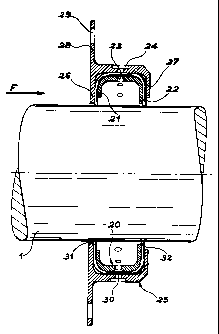Some of the information on this Web page has been provided by external sources. The Government of Canada is not responsible for the accuracy, reliability or currency of the information supplied by external sources. Users wishing to rely upon this information should consult directly with the source of the information. Content provided by external sources is not subject to official languages, privacy and accessibility requirements.
Any discrepancies in the text and image of the Claims and Abstract are due to differing posting times. Text of the Claims and Abstract are posted:
| (12) Patent: | (11) CA 2291606 |
|---|---|
| (54) English Title: | DUAL-CONTACT BRUSH SEAL |
| (54) French Title: | BALAI D'ETANCHEITE A DOUBLE CONTACT |
| Status: | Term Expired - Post Grant Beyond Limit |
| (51) International Patent Classification (IPC): |
|
|---|---|
| (72) Inventors : |
|
| (73) Owners : |
|
| (71) Applicants : |
|
| (74) Agent: | LAVERY, DE BILLY, LLP |
| (74) Associate agent: | |
| (45) Issued: | 2008-02-05 |
| (22) Filed Date: | 1999-12-01 |
| (41) Open to Public Inspection: | 2000-06-10 |
| Examination requested: | 2004-10-22 |
| Availability of licence: | N/A |
| Dedicated to the Public: | N/A |
| (25) Language of filing: | English |
| Patent Cooperation Treaty (PCT): | No |
|---|
| (30) Application Priority Data: | ||||||
|---|---|---|---|---|---|---|
|
The present invention relates to a dual-contact brush seal that is easy to produce and assemble. It mainly comprises a single flexible strip of strands or brush fibers (30) that is contained within a body constituted by an inner crown (20) and an outer crown (25). The two crowns are U-shaped such that they can be used to position the two ends (31, 32) of the flexible strip (30) against the outer surface of revolving shaft (1). Preferably, the arms of the two crowns (20 and 25) are of different lengths and face each other.
La présente invention concerne un balai d'étanchéité à double contact qui est facile à produire et à assembler. Il comprend essentiellement une seule bande souple de brins ou de fibres de brosse (30) qui sont contenus dans un corps constitué par une couronne intérieure (20) et une couronne extérieure (25). Les deux couronnes sont en forme de U de telle sorte qu'ils peuvent être utilisés pour positionner les deux extrémités (31, 32) de la bande souple (30) contre la surface extérieure de l'arbre rotatif (1). De préférence, les bras des deux couronnes (20 et 25) sont de longueurs différentes et se font face.
Note: Claims are shown in the official language in which they were submitted.
Note: Descriptions are shown in the official language in which they were submitted.

2024-08-01:As part of the Next Generation Patents (NGP) transition, the Canadian Patents Database (CPD) now contains a more detailed Event History, which replicates the Event Log of our new back-office solution.
Please note that "Inactive:" events refers to events no longer in use in our new back-office solution.
For a clearer understanding of the status of the application/patent presented on this page, the site Disclaimer , as well as the definitions for Patent , Event History , Maintenance Fee and Payment History should be consulted.
| Description | Date |
|---|---|
| Inactive: Expired (new Act pat) | 2019-12-02 |
| Common Representative Appointed | 2019-10-30 |
| Common Representative Appointed | 2019-10-30 |
| Revocation of Agent Request | 2018-09-14 |
| Appointment of Agent Request | 2018-09-14 |
| Inactive: Agents merged | 2018-09-01 |
| Appointment of Agent Request | 2018-08-30 |
| Inactive: Agents merged | 2018-08-30 |
| Revocation of Agent Request | 2018-08-30 |
| Inactive: IPC expired | 2016-01-01 |
| Letter Sent | 2008-02-22 |
| Letter Sent | 2008-02-22 |
| Letter Sent | 2008-02-22 |
| Letter Sent | 2008-02-22 |
| Letter Sent | 2008-02-22 |
| Letter Sent | 2008-02-22 |
| Letter Sent | 2008-02-22 |
| Grant by Issuance | 2008-02-05 |
| Inactive: Cover page published | 2008-02-04 |
| Pre-grant | 2007-11-16 |
| Inactive: Final fee received | 2007-11-16 |
| Notice of Allowance is Issued | 2007-05-30 |
| Notice of Allowance is Issued | 2007-05-30 |
| Letter Sent | 2007-05-30 |
| Inactive: Approved for allowance (AFA) | 2007-05-18 |
| Amendment Received - Voluntary Amendment | 2007-03-01 |
| Inactive: S.30(2) Rules - Examiner requisition | 2006-09-06 |
| Amendment Received - Voluntary Amendment | 2005-08-30 |
| Letter Sent | 2004-11-09 |
| All Requirements for Examination Determined Compliant | 2004-10-22 |
| Request for Examination Requirements Determined Compliant | 2004-10-22 |
| Request for Examination Received | 2004-10-22 |
| Letter Sent | 2003-11-13 |
| Letter Sent | 2003-11-13 |
| Application Published (Open to Public Inspection) | 2000-06-10 |
| Inactive: Cover page published | 2000-06-09 |
| Letter Sent | 2000-02-08 |
| Inactive: IPC assigned | 2000-01-24 |
| Inactive: IPC assigned | 2000-01-24 |
| Inactive: IPC assigned | 2000-01-24 |
| Inactive: First IPC assigned | 2000-01-24 |
| Inactive: Single transfer | 2000-01-17 |
| Inactive: Courtesy letter - Evidence | 2000-01-11 |
| Application Received - Regular National | 2000-01-07 |
| Filing Requirements Determined Compliant | 2000-01-07 |
| Inactive: Filing certificate - No RFE (English) | 2000-01-07 |
There is no abandonment history.
The last payment was received on 2007-11-23
Note : If the full payment has not been received on or before the date indicated, a further fee may be required which may be one of the following
Please refer to the CIPO Patent Fees web page to see all current fee amounts.
Note: Records showing the ownership history in alphabetical order.
| Current Owners on Record |
|---|
| SNECMA |
| Past Owners on Record |
|---|
| DANIEL GEORGES PLONA |
| MONIQUE ANDREE THORE |